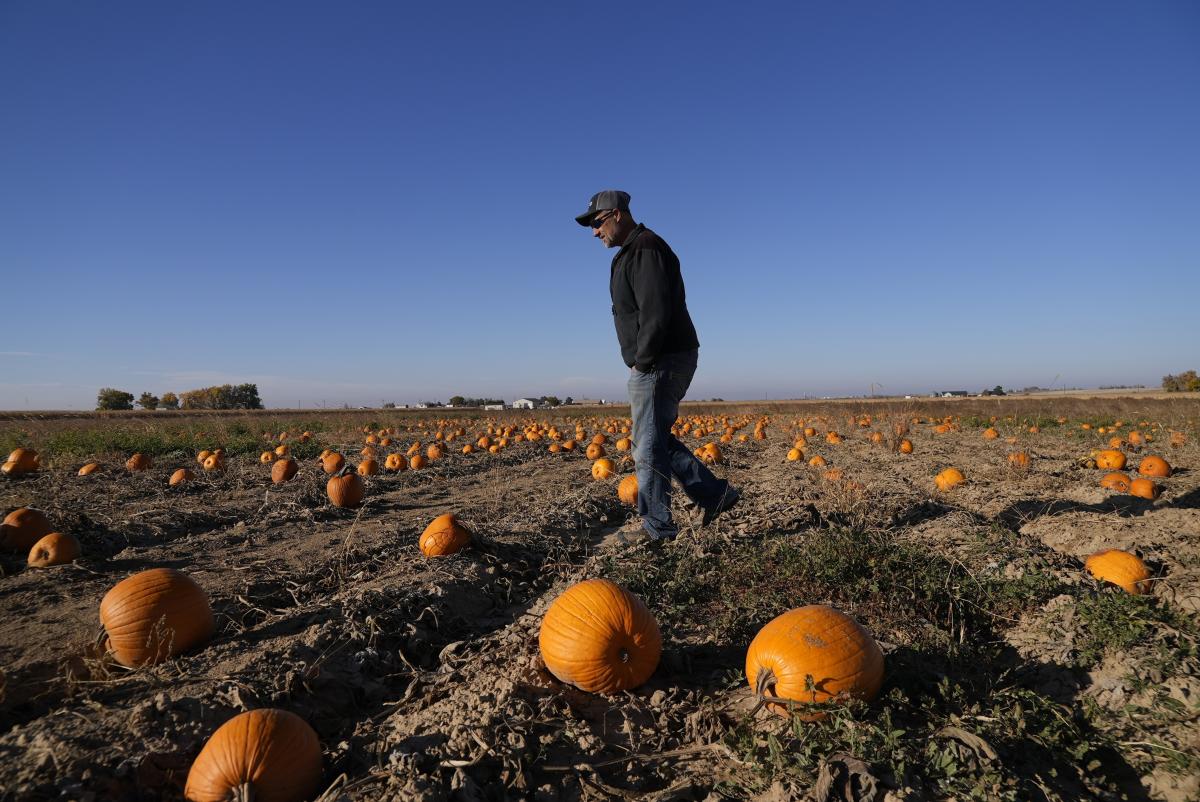Hudson, CO. (AP) —
Alan Mazzotti has a clear view of the Rocky Mountains from his pumpkin patch in northeast Colorado, located about 30 miles west. Mazzotti enjoys the sight of the snow-capped peaks, especially after a winter with abundant snowfall. He and his family even had the opportunity to experience the snowy season firsthand when they visited the Winter Park Resort for some winter fun.
However, the increased snowfall from the previous winter wasn’t enough to replenish Mazzotti’s dwindling reservoir, which he heavily relies on for irrigating his pumpkin crop. When he received the news in the spring that his water delivery would be reduced by half compared to the previous season, he made the decision to plant only half of his usual pumpkin crop. Unfortunately, heavy rains in May and June created a muddy mess in the fields, preventing any additional planting that farmers may have wanted to do.
“By the time it started raining and affecting our reservoir supplies, it was too late for this year’s crop,” lamented Mazzotti.
For pumpkin growers in states like Texas, New Mexico, and Colorado, this year’s harvest served as a stark reminder of the water challenges faced by agriculture in the Southwest and West. Human-caused climate change has exacerbated drought and heat extremes, leading to water shortages. Some farmers experienced yield losses of 20% or more, while others, like Mazzotti, had to leave portions of their land bare. Additionally, rising labor costs and inflation have further narrowed farmers’ profit margins when selling their produce to garden centers and pumpkin patches.
This year’s parched pumpkins symbolize the ongoing struggle faced by farmers who rely on irrigation. They have to carefully choose which acres to plant based on water allotments and the cost of pumping water out of the ground. They must also decide which crops are worth the risk of enduring hotter and drier summers.
Pumpkins can withstand hot and dry weather to some extent. However, this summer’s record-breaking heat and temperatures exceeding 100 degrees Fahrenheit (38 degrees Celsius) proved to be too much for them. Mark Carroll, a Texas A&M extension agent, referred to this year as one of the worst in recent memory. The scorching and dry conditions surpassed what irrigation could compensate for. Furthermore, pumpkins need cooler temperatures for proper harvesting. Without them, the pumpkins can start decomposing during the shipping process, sometimes disintegrating before reaching stores.
Illinois, the pumpkin powerhouse of America, experienced a successful harvest comparable to the past two years, according to the Illinois Farm Bureau. However, in Texas, the heat persisted into the harvest season, putting farmers in a difficult position. They had to decide whether to risk cutting the pumpkins off the vines at the usual time or wait and miss the start of the fall pumpkin rush. Additionally, as groundwater levels continue to drop, irrigation costs have surged, resulting in thousands of dollars in monthly energy bills for some farmers.
Lindsey Pyle, a North Texas pumpkin farmer, has also seen her energy bills rise along with the increasing costs of supplies, chemicals, seeds, and fuel. She lost about 20% of her pumpkin yield. Pyle also emphasized the unpredictable nature of pumpkin growth earlier in the season. Lush and green vines do not guarantee fruit production if the plants aren’t receiving sufficient water.
Steven Ness, a farmer in central New Mexico, highlighted the rising cost of irrigation as a widespread issue affecting farmers in the region. This cost factor often influences crop selection. If corn and pumpkins require similar amounts of water, farmers may choose to grow pumpkins due to their higher profitability per acre. However, Ness stressed that the real challenge lies in the lack of deep moisture and water in the aquifer, a problem exacerbated by long-term overuse and reduced precipitation caused by climate change.
Jill Graves, who added a pumpkin patch to her blueberry farm in Texas, had to abandon growing their own pumpkins this year and source them from a wholesaler instead. Although the purchased pumpkins rotted faster than in previous years, it was still a better outcome than their own meager harvest. Despite this setback, Graves remains hopeful and plans to try growing pumpkins again next year.
As for Alan Mazzotti, he believes that without enough water, farming becomes a futile endeavor. However, he perceives labor costs as an even greater challenge. Water cutbacks have been a long-standing issue for Colorado farmers, and they have adapted to it. Nevertheless, unlike corn, pumpkins cannot be harvested by machines and require substantial manual labor to determine ripeness, cut them off the vines, and prepare them for shipping.
Mazzotti relies on guest workers from the H-2A program, but a recent Colorado law mandates overtime pay for farm workers, unlike in most states. This requirement makes it difficult to compete with states where labor costs are lower. When combined with rising irrigation costs and other expenses, Mazzotti describes the situation as a “no-win situation.” He plans to continue farming pumpkins for a while, but acknowledges that there may not be a future for his sons in farming.
___
Walling reported from Chicago.
___
Read more about AP’s climate coverage at http://www.apnews.com/climate-and-environment
___
Follow Melina Walling and Brittany Peterson on X, formerly known as Twitter: @MelinaWalling and @BrittanyKPeters
___
Associated Press climate and environmental coverage is supported by several private foundations. Learn more about AP’s climate initiative here. The AP is solely responsible for all content.


